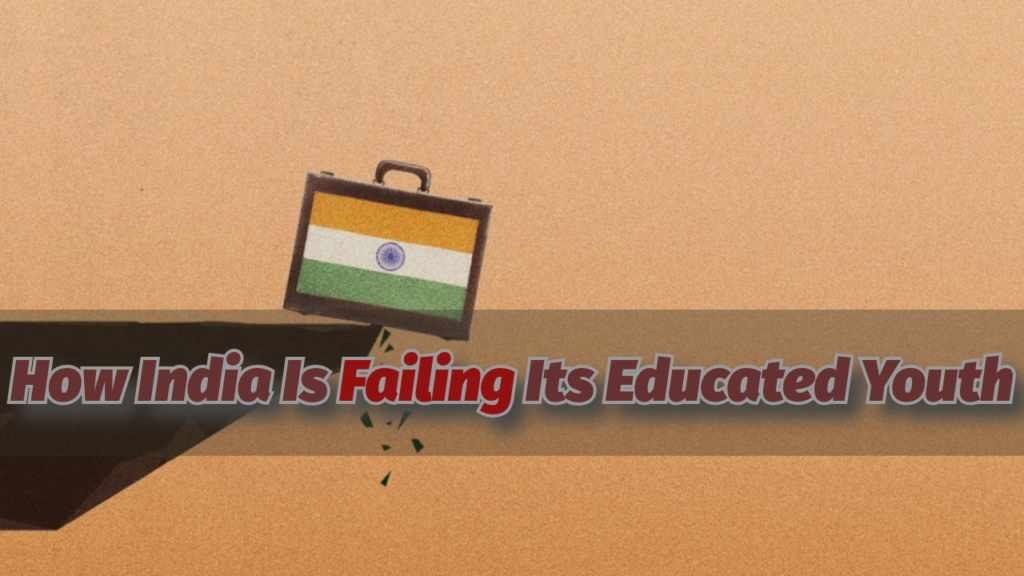India’s Employment Challenge: An In-Depth Analysis
India is often hailed as the world’s fastest-growing major economy, yet beneath the promising statistics lies a stark reality—India is failing its educated youth, with millions struggling to find quality jobs despite impressive qualifications. This disillusionment is widespread and growing, highlighting the country’s inability to create enough employment opportunities for its expanding population.
Table of Contents
- The Root of the Problem
- Key Factors Contributing to the Crisis
- The Political and Economic Implications
- Path to Overcoming the Employment Crisis
- Conclusion
- Frequently Asked Questions (FAQs)
The Root of the Problem

Despite a vast young workforce, India faces an employment crisis. Job creation has lagged behind, with many educated individuals unable to secure stable employment. According to research, unemployment among 20- to 24-year-olds has risen to over 42%. Even those with university degrees, like 29-year-old Chandan Kumar, are forced to take informal jobs like food delivery. The mismatch between the education system and market demands is a central issue, as many institutions provide outdated curricula that leave graduates ill-prepared for the workforce.
Key Factors Contributing to the Crisis
- Lack of High-Quality Jobs: India has created millions of jobs over the last decade, but only about 10% of them were in the formal sector. The vast majority of the workforce is employed in the informal sector, where they receive no benefits or job security.
- Weak Private Investment: Despite the country’s economic growth, private investment remains weak. This shortfall has hindered the creation of high-quality jobs that could absorb India’s massive educated workforce.
- Educational Mismatch: The education system does not equip students with the necessary skills for the job market. Many institutions employ undertrained teachers and outdated teaching methods, leaving graduates unprepared for the competitive job market.
- Female Workforce Participation: Despite near-equal enrollment rates in higher education, India’s female labor participation is among the lowest in the world. Societal expectations for women to act as primary caregivers prevent many from entering the workforce, further compounding the employment challenge.
The Political and Economic Implications

India’s inability to address unemployment has significant political and economic consequences. In the 2024 national elections, Prime Minister Narendra Modi’s BJP lost its parliamentary majority partly due to a failure to deliver on job creation promises. Additionally, India’s per capita income remains low, and the wealth gap continues to widen, threatening the country’s ambition of becoming a developed economy by 2047.
Path to Overcoming the Employment Crisis
India’s employment challenge is daunting, but several strategies can be implemented to address this growing problem:
- Reforming Education: India must revamp its educational system to focus on skills that align with modern industry demands. Introducing vocational training and collaboration between educational institutions and businesses can help bridge the gap between degrees and employability.
- Encouraging Private Investment: The government needs to incentivize private companies, both domestic and foreign, to invest in India’s economy. This can be achieved by simplifying labor laws, reducing bureaucratic hurdles, and offering tax breaks to companies that set up manufacturing units in India.
- Expanding the Manufacturing Sector: Despite Prime Minister Modi’s goal of making the manufacturing sector 25% of India’s GDP, this target remains unmet. Strengthening this sector by offering greater incentives to industries like technology, electronics, and textiles can create more jobs.
- Supporting Small and Medium Enterprises (SMEs): India’s SMEs are crucial to job creation but often struggle with access to capital and excessive red tape. Simplifying regulations and providing financial support to these businesses can help stimulate job growth.
- Empowering Women: Closing the gender gap in employment can significantly boost India’s GDP. By promoting policies that encourage women’s participation in the workforce, such as affordable childcare and flexible working hours, India can increase its labor force participation rate and stimulate economic growth.
- Improving Labor Force Participation: India’s labor force participation rate is low compared to other countries. Providing incentives for people to enter the workforce, such as job guarantee schemes and improved working conditions, can increase employment levels.
- Focusing on Exports: Strengthening export capabilities can generate millions of jobs. India should focus on sectors where it can become a global leader, such as textiles, pharmaceuticals, and technology, by promoting “Make in India” policies.
Conclusion
India faces a critical challenge in addressing the employment needs of its educated youth. By reforming education, promoting private investment, supporting SMEs, and empowering women, the country can overcome its employment crisis and unlock its full economic potential. Without these crucial reforms, India risks leaving millions of young, qualified individuals like Chandan Kumar behind, unable to contribute fully to the growth of one of the world’s largest economies.
This article is inspired by this YouTube video.
Frequently Asked Questions (FAQs)
- What is the current unemployment rate among India’s youth?
- As of recent reports, the unemployment rate among 20- to 24-year-olds in India exceeds 42%.
- Why is there a high unemployment rate among educated youth in India?
- The high unemployment rate is due to a mismatch between the education system and job market requirements, along with insufficient high-quality job creation.
- What is the primary issue with India’s education system in relation to employment?
- The education system often provides outdated curricula and lacks practical training, which leaves graduates unprepared for the modern job market.
- How many jobs created in India are in the formal sector?
- Only about 10% of the jobs created in India are in the formal sector, with the majority in the informal sector.
- What role does private investment play in job creation in India?
- Private investment is crucial for creating high-quality jobs. Weak private investment hampers the generation of formal sector employment opportunities.
- How does the informal sector impact job security for workers?
- Workers in the informal sector typically lack job security and benefits, making their employment situation more precarious compared to those in the formal sector.
- What are some of the challenges faced by small and medium enterprises (SMEs) in India?
- SMEs often struggle with access to capital and face excessive regulatory hurdles, which can hinder their ability to create jobs.
- How does gender disparity affect employment in India?
- Despite high enrollment rates in higher education, women’s labor force participation is among the lowest globally due to societal expectations and caregiving roles.
- What are the implications of high unemployment for India’s economy?
- High unemployment can lead to economic stagnation, widening wealth gaps, and decreased consumer spending, impacting overall economic growth.
- What steps can be taken to reform India’s education system?
- Reforms could include updating curricula, increasing vocational training, and fostering partnerships between educational institutions and industry.
- How can the Indian government encourage private investment?
- By simplifying labor laws, reducing bureaucratic barriers, and offering tax incentives, the government can attract more private investment.
- Why is expanding the manufacturing sector important for job creation?
- Expanding manufacturing can create numerous jobs and strengthen India’s economy, especially if targeted at technology, electronics, and textiles.
- What strategies can support the growth of SMEs?
- Strategies include simplifying regulations, providing financial support, and improving access to capital for SMEs.
- How can women’s participation in the workforce be increased?
- Policies such as affordable childcare, flexible working hours, and workplace equality can help boost women’s participation in the workforce.
- What is the significance of improving labor force participation rates?
- Increasing labor force participation rates can help reduce unemployment and underemployment, contributing to overall economic growth.
- What impact does low labor force participation have on India’s economy?
- Low labor force participation can limit economic productivity and growth, as fewer people are actively contributing to the economy.
- How can India focus on exports to create jobs?
- By enhancing export capabilities in sectors where India can lead globally and promoting “Make in India” initiatives, job creation can be stimulated.
- What are the benefits of vocational training in the education system?
- Vocational training provides practical skills that align with industry needs, improving graduates’ employability and readiness for the job market.
- How does weak private investment affect job creation?
- Weak private investment limits the creation of high-quality jobs and slows down economic growth, affecting overall employment opportunities.
- What can be done to address the educational mismatch in India?
- Updating educational content, improving teacher training, and aligning curricula with industry demands can help address the educational mismatch.



